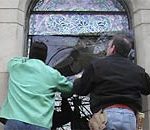The Restoration Process: The Lord is My Shepherd
Tiffany Glass & Decorating Co., NYC
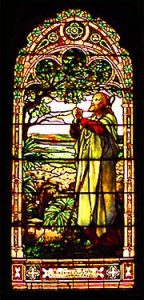
In 1894, as this exceptional window was being installed in the baptistery of St. John’s Lutheran Church in Rochester, NY, Tiffany’s swirling, draping opalescent glass was causing a revolution in the art form.
Originally a painter, Tiffany longed to ‘paint’ with glass, to represent nature and its lush palette in his work. He soon developed a new process in which colors were combined and manipulated within the glass to create an amazing range of hues and dimensional effects. He also devised a method of assembling the glass pieces with thin copper foil—often in several layers—so as not to interrupt his flowing, intricate lines.
Now over a hundred years old, many of Tiffany’s masterworks, like The Lord is My Shepherd, must be cleaned and releaded. Yet these windows, while exquisite, are also bulky and complex, and require expert skills to dissemble and restore.
In this case study, Jeffrey Mueller, owner of Godfrey Muller Studios, presents a step-by-step account of how this delicate restoration was carried out.
Step 1: Reinforce and Remove
First, workers remove the exterior protective glazing and tape the window securely for support. It’s found that the century-old lead and solder joints are severely oxidized—without proper taping, the 100-pound, multi-layer panels could easily break apart. However, only the outside can be taped, the painted surface inside must be protected from contact.
After the glazing around each window edge is carefully chipped away, interior tie wires are cut, releasing the panel from the steel saddle bars. Each panel is then attached to a plywood support and packed for transport to the studio.

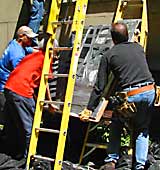
Step 2: Create Rubbings
Before leaving the site, measurements and patterns of the curved window frame are made. Back in the studio, precise measurements are made of the intact panels. Size and position of support bars, tie wires, lead came and copper foil are all clearly marked.
A system of color codings on the rubbings will assist in reassembly by indicating the specific materials used.
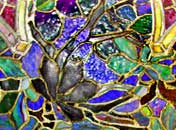
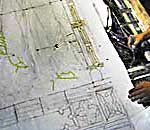
Step 3: Remove Back Layers
The window is then turned face-down, and two layers of glass are removed.
This window, in some areas, is found to be four or five layers thick. It was Tiffany’s practice to continually scrutinize each project, adding layers of glass to both the front and back in order to achieve the precise color and light effects he desired.
Careful rubbings are made as each layer is removed to record the often irregular position of each segment of glass.

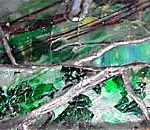
Step 4: Remove Top Layers
The panel is then turned over and the front layers removed. While each strip of lead came typically holds a single layer of stained glass, some sections of complex Tiffany windows contain two layers of glass bound within a single strip of custom-extruded “high-hearted” lead.
Finally, the main design layer is exposed and another pattern is made.
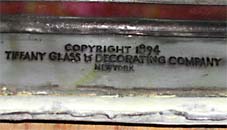
Step 5: Fully Dissemble
After the old lead is removed, sections of copper-foiled glass must be dissembled. To get to the foil, solder must be carefully melted off with a soldering iron.
Once exposed, much of the old copper is found to have corroded, both from oxidation and possibly from the acidic soldering flux used in Tiffany’s day. Restorers now use less acidic materials on the leads.
Finally, the tiny segments of glass are marked and pulled apart.
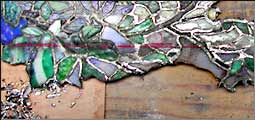
Step 6: Clean and Repair
Each piece of glass is then hand washed in a non-ionic cleaner. Painted sections are carefully dusted so there’s no risk of loosening original paint. Cracked and broken segments are set on a light table for gluing, allowing the technician to perform precisely-aligned repairs.
This window, it was discovered, contained one layer of confetti glass that apparently had not been annealed properly. Over time, stress in the glass caused it to shatter into tiny fragments. Removing the supporting foil allowed the fragments to separate, necessitating meticulous gluing.
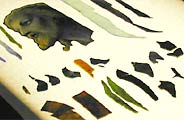
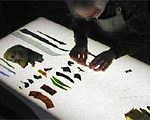
Step 7: Copper Foil, Lead and Solder
The patterns are then laid out and reassembly begins. Layer by layer, tiny glass segments are set in place, then refoiled and releaded, beginning with the main design layer.
For sections of this window, double-high lead had to be custom cast. Antique dies were located and new lead was extruded. These leads were further shaped with a plane to match the exact dimensions of the original. Another unusual feature of this window is Tiffany’s lead foil, cut from thin sheets, used in place of copper. This foil also had to be recreated during restoration.
Each assembled layer is then resoldered.
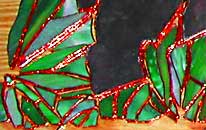
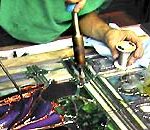
Step 8: Cementing
After the main design layer is fully assembled, it’s cemented on both sides. Cement putty is brushed into areas between the lead and glass. The excess is cleaned off with powdered calcium carbonate which absorbs residual oils.
Back and front layers are successively positioned and soldered on, then cemented as necessary.

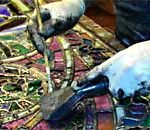
Step 9: Support Bars and Tie Wires
Approximately 100 fourteen-gauge copper tie wires are soldered onto the lead to be used in securing the window to its support bars. Tie wires are carefully positioned in the structural joints in order to minimize stress on the glass.
The original steel support bars, known as saddle bars, are cleaned and inspected. Still in sound condition, they’re readied for reinstallation.
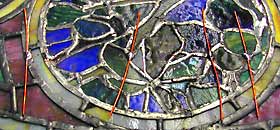
Step 10: Final Cleaning and Installation
Residual putty in the frame is carefully chiseled out to assure a secure, airtight fit. The fully assembled window is also given a final cleaning.
Once the window is in place, a removable protective covering is installed on the outside. To avoid condensation and heat build-up in the air space, this protective glazing is vented top and bottom. Proper air circulation is essential to keep the restored window in top condition.

